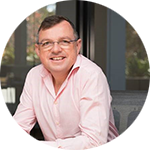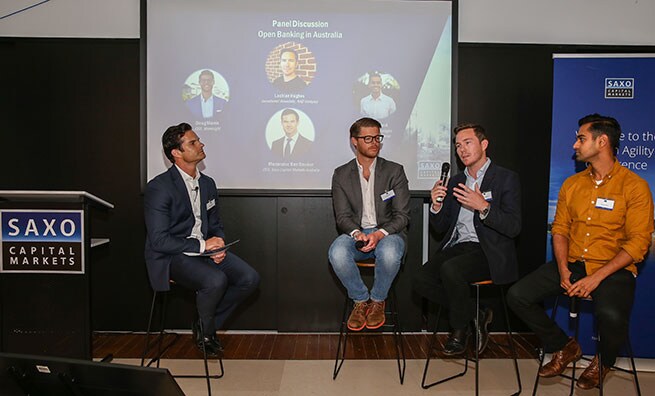Saxo fintech agility conference

Nik Kritikos
Country Head of Origination, Saxo Capital Markets
The traditionally competitive relationship between fintechs and financial institutions will become increasingly collaborative over the next few years, a process that is already underway, according to Nik Kritikos, Country Head of Origination, Saxo Capital Markets.
Mr. Kritikos told the Saxo Fintech Agility Conference at fintech hub Stone & Chalk in Sydney that banks have traditionally taken the route of building technology that underpins their value chain rather than curating third party solutions to support their core competencies. “This is inefficient in our eyes, and takes the banks’ attention from what they should be focusing on— relationships and client service,” he said.
Financial institutions are under increasing pressure to innovate or be left behind by their customers who are demanding the services of the future. However, many are struggling to innovate because of their large legacy technology systems.
Banks spend 80% of their IT budget maintaining legacy systems. Despite this, Wayne Byres, Chairman of the Australian Prudential Regulation Authority, recently said banks have been spending too little on maintaining their computer systems, leaving them with a backlog of maintenance and a patchwork of systems, and resulting in them being under prepared for the new Open Banking regime.
With the majority of their IT budget going to maintenance rather than innovation, the only way many financial services organisations will be able to compete with smaller, more innovative groups is by partnering with fintechs that can act as enablers for them. “Increasingly, financial institutions are realising they need to partner with more nimble, innovative players or be left behind by their customers who are demanding the services of the future,” Mr Kritikos said.
One example of this trend is the recently established partnership Saxo and OpenMarkets. As part of this partnership, Saxo provides OpenMarkets access to trading infrastructure for global securities, which OpenMarkets offers to their clients under their own brand.

Ben Heap
Founding Partner, H2 Ventures
While “fintech” has become a buzzword, it isn’t a new concept. Ben Heap, founding partner of early stage venture capital firm H2 Ventures, says financial services has been a technology driven industry for about 400 years. So what has changed in recent times to drive the explosion in fintech innovation we’ve seen over the past five years?
Mr. Heap told the Saxo Fintech Agility Conference that fintech has gone through three stages since the emergence of the Internet.
Firstly, in the early 1990s, the Internet was seen as “very much a tool to be looked at from a distance—not something you trusted but something that had the capacity to do a lot more in the future.”
Secondly, around 2005, there was an explosion of social media platforms including LinkedIn and Twitter. “That’s where people started trusting the Internet in so far as they would put their holiday photos on it.”
The third phase began around 2010 when people began thinking about the Internet as a tool that they are able to trust “frankly, in many cases, to a greater degree than they might trust an individual.”
“Fintech is no longer just a cost saving type of product or solution. Rather it is a solution that for consumers is better than what has been available before. This is why fintech has exploded,” said Mr. Heap, who is also a member of the Australian government’s Fintech Advisory Group, and considered one of the foremost fintech specialists in Australia.
He notes research done at a European investment bank where he previously worked. The research, conducted about six years ago, found that the bank’s “very, very wealthy” high net worth customers preferred to deal with a digital interface rather than receive face-to-face advice in a personal relationship with a well-dressed banker across a dining table, which had been the way advice was delivered in the past.
“They were utterly blown away by the result. They dived into that and found that if you are a wealthy European industrialist, you actually don’t want to tell your banker that you don’t altogether understand what a zero coupon bond is or how a hedge fund works, and so your default position is to turn stuff away. But the idea of a digital platform where you can ask a lot of dumb questions and interact was very powerful. “
Predictions
Initial Coin Offerings (ICOs) have the potential to make available globally all sorts of interesting products and services and solutions. They will “go into a terrible hole which is the bust then will steadily grow and become important role in the landscape,” he said.
Blockchain is going to “completely and utterly change the world”, says Mr. Heap, noting that Chinese state media has reported the value of blockchain is ten times more than the Internet. However, he said the field of businesses operating in the area will eventually narrow sharply. “In 1908 in the US, there were 500 car manufacturers. Ten years later there were three, which for the next 60 or 80 years dominated the US industry.
And that’s what is happening at the moment. There are thousands of people experimenting in blockchain, some building businesses that will be successful, others building things that will fall over. Out of that will come a handful of businesses that will be really impactful globally.”
On crypto currencies specifically, he predicted that the Chinese government will at some point launch a digital sovereign currency, representing the biggest threat to the US dollar as the reserve currency around the world.
Turning his attention to Australia, he said if we don’t stay at the front edge of financial services, “global players are just going to come in here and eat our lunch”. “In a heartbeat they will just offer ten times better services that consumers will take up by force. And before we know it, what is our second biggest employing industry and our biggest taxpaying industry in the country, financial services, will be decimated. “
On the banks, he said there will be “big winners and big losers” among the traditional players. “I subscribe to the view that you will absolutely not have all the big incumbent banks that you have now. I’m certain not all four will disappear off the landscape. But I’m equally certain not all four will just be sitting there in an oligopoly scenario with the four pillars policy. I think that’s where we’ll see real change.”

Neils Maartens
Chief Operating Office, YBF Ventures
Ever thought about starting your own fintech hub? Niels Maartens is the chief operating officer of YBF Ventures, Victoria’s flagship startup community and innovation hub, which includes the Victorian Fintech Hub.
He told attendees of the Saxo Fintech Agility Conference what it takes to foster fintech innovation within an innovation hub. His comments are equally interesting whether you are considering starting a fintech hub, joining one, or investing in the sector.
Focus on themes
Firstly, he said it is important to identify key themes on which to focus. When YBF first started the fintech hub, it asked several of its corporate partners, who include the likes of NAB, Deloitte, Salesforce and Allianz, to name some of the main themes they believed would be at the forefront of fintech. Four key themes emerged: Open Banking; insurance; wealth and superannuation; and Web 3.0 and identity.
Base a fintech hub among other technologies
At YBF, there is no separate section reserved for fintechs. Just as fintech pervades the entire economy in the real world, YBF mixes fintech founders with other technology companies.
“Fintech dosen’t exist in isolation. We are proactively mixing verticals. Half the floor is fintech. We have payment platforms sitting right next to augmented reality providers. And it is working.”
Already YBF has seen collaboration between fintechs and a raft of other company types including augmented reality, virtual reality, machine learning, customer experience, health, agriculture and energy.
Be informed
Proximity isn’t enough. The operators of the hub must actively engage with members to foster connections, and they need the background to know how to do that.
“It’s important to have a financial services literate group that sniffs out and connects people actively together,” Maartens said.
If the space is large enough, corporate partners can be brought in and located right in the middle of the startups. EY inhabits a space in the middle of the YBF offices.
Stay long term
In order to be sustainable, it is important to create a fintech hub that makes long-term commercial sense, said Maartens. At YBF, 95% of members pay commercial levels of rent, and grants are used to accelerate plans, not to subsidise operational costs or member rates. YBF’s fintech hub is cashflow positive on an ongoing basis.

Luke Bunbury
Found and Deputy CEO, Volt Bank
Luke Bunbury and Steve Weston had their own Ocean’s Eleven moment last year when they decided to take on Australia’s major banks by creating the country’s first digital bank.
“We were two capable people but we needed more capable people,” Mr. Bunbury told attendees of the Saxo Fintech Agility Conference. “So we hit the phones and talked to the best guys and girls that we ever worked with—from Washington, to London, to Singapore, and South Africa, and here in Australia of course. We said to people, ‘Things are changing in Australia. We are looking at getting a bank license. Do you want to come on board?’ And to a person, they did.”
While Danny Ocean’s decision to team up with partner-in-crime Rusty Ryan to recruit eight former colleagues for a casino heist was sparked by Ocean’s release from prison in the movie, Mr. Bunbury said he and Mr. Weston were prompted by a different kind of development – an announcement in the federal budget.
Up until recently, the regulatory requirements around getting a bank license in Australia were onerous, so onerous in fact that the last time a startup bank entered the market was back in 1981, with the creation of Australian Bank. However, the federal budget last year included measures to reduce the barriers for innovative new entrants, including relaxing minimum capital requirements and the 15% ownership cap.
“Steve Weston and I had worked together at St George and then Challenger Financial Services bank in the late 1990s/early 2000s, through the 2000s and into the GFC. We had a hankering to get back into financial services. We were pretty keen to go and do something together, but the prospect of a banking license was just out of reach. The budget changed that and so we reformatted our thinking about what we could do in financial services.”
Besides the licensing changes, there were other factors that made it a good time to start a digital bank in Australia.
One factor, he said, is “NOMOPHOBIA”, defined as “The fear of being without a mobile phone” or “The anxiety a person feels when not in range of a cell tower”, and the increasing tendency of people to use and transact on their mobile devices.
“That the device has become so popular has fundamentally shifted financial services and created opportunities for new entrants like us. Customers are no longer interested in going into a bank branch,” Mr. Bunbury said.
It’s not just consumer behaviour that has created an opportunity for new entrants in financial services, he said. Technological developments also mean it is now much more affordable to start a bank.
“The reality is if it were a decade ago, it would have cost us some factor of tens more than what it is costing today,” Mr. Bunbury said.
However, it won’t be enough to create a digital version of what banks already offer.
“Customers are looking for a lot more from their providers, whether it is in financial services or other sectors. Just because a customer has three or four products with a bank doesn’t mean they are going to buy their next product from that bank. They will give loyalty to a provider but that provider has to earn that loyalty, and continue to earn it.”
Customers also want more than just financial products.
“Customers are saying, “Don’t just sell me a mortgage, help me buy a house. Don’t just give me a savings account, but help me get to my savings goal,” Mr. Bunbury said.
“We talk about a savings journey at Volt. Typically that journey has about 12 steps. Today a bank will do one of those steps—they’ll give you savings account. ”
Mr. Bunbury said success for him would be when Volt helps a customer pay off their mortgage at Westpac.
“That would be right for that customer, and that would not only entrench loyalty, it would create advocacy. So it’s an incredibly economically rational thing to do, it’s also the right thing to do from a customer perspective.”

The introduction of Open Banking is a “catalytic event” that will open up the data economy in Australia. That’s the view of Lachlan Hughes, Investment Associate of NAB Ventures.
Lachlan was among a panel of speakers that discussed the topic of Open Banking in Australia at the Saxo Fintech Agility Conference.
Mr. Hughes said NAB Ventures, a venture capital fund backed by NAB, believes Open Banking will lead to many interesting investment opportunities.
Also on the panel was Rohen Sood, Investment Manager at Reinventure Group, a venture capital fund to which Westpac has committed $150 million, noted that Open Banking is the first pillar of the Consumer Data Right legislation being introduced in Australia.
“From an investment perspective, access to consumer data is a bit of a holy grail, as it gives insights into what people are actually doing versus what they say they are doing.”
The panelists said a major area of opportunity initially will be in the development of the infrastructure that facilitates the movement of consumer data.
The infrastructure for moving data around is not really down yet so that will be the first stage,” said Mr. Hughes. “Once that’s down, and the data is accessible, some interesting applications that might sit on that would be B to C (business to consumer) PFM (personal finance management) software, which has not been so successful to date. Ultimately, data is fuel AI (artificial intelligence)—once you start pumping some more data through it, you’ll learn some really interesting things and be able to create some pretty compelling experiences.”
Mr. Sood said collaboration is more likely than collision when it comes to the relationship between fintechs and financial institutions. “Fintechs are at the stage now where collaboration can help them get distribution.. How that evolves is another matter—it may change as fintechs get bigger.”
Mr. Hughes said we are likely to see more of both collision and collaboration. One strong opportunity for collaboration will be the migration of banks to the cloud. “Open Banking is going to accelerate the cloud migration/digital transformation that all banks are going through. That creates the opportunity to work with fintechs in a way that they haven’t before.”
Doug Morris, CEO of fintech Sharesight, a founding member of Fintech Australia, said collaboration is key. “We don’t expect an Apple or Uber to come along and disrupt the banks,” he said. ”We like to work with banks—banks have customers. The way we see the world is like a vertical stack. The banks have a stack of technology, and there are all these fintechs attacking the stack at different levels. So there’s not going to be one fintech taking it all out. It is going to be collaboration with the banks at different levels of the stack.”

